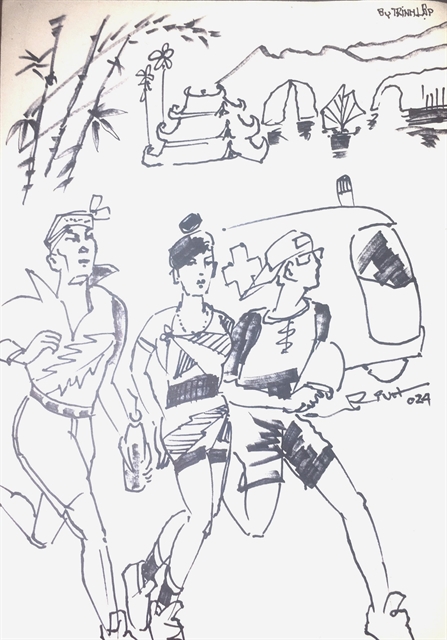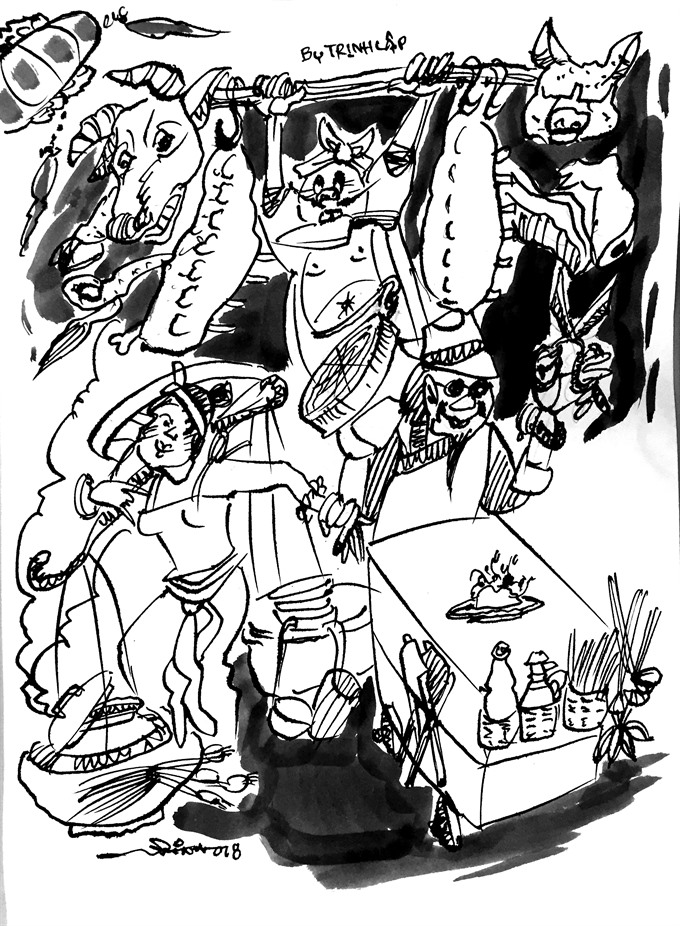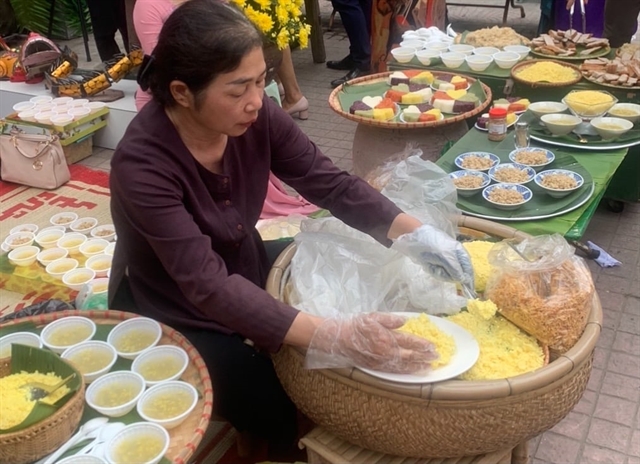 Talk Around Town
Talk Around Town

Việt Nam has one of the most diverse and appealing cuisines in the world. However, due to changes in lifestyle and culture, or the influence of foreign cuisines, numerous dishes have changed from the original flavours that made them famous.
 |
| Illustration by Trịnh Lập |
Nguyễn Phương Linh
Việt Nam has one of the most diverse and appealing cuisines in the world with local specialties that have become globally famous like phở, bún chả and bánh mỳ. These dishes have been served up for years, and never fail to attract domestic and foreign diners.
However, due to changes in lifestyle and culture, or the influence of foreign cuisines, numerous dishes have changed from the original flavours that made them famous.
Challenging traditional flavours
Hoàng Thu, an American with Vietnamese origin, remembers the taste of sticky rice with mung beans which she adored during her childhood. With just steamed glutinous rice, fragrant mung beans and deep-fried shallots, the dish brought a warm tasty glow during cold winter days.
“I don’t understand why sticky rice with mung beans has changed. Now it has pâté, pork, particularly, Chinese braised pork. The delicate taste of the old days is unrecognisable” she said.
Thu’s beloved sticky rice with mung beans is not the only dish that has become meatier. Numerous dishes have added different types of meat and lost their refined flavours. Among these dishes are snail and crab vermicelli. In the past, the core of these dishes was their meticulously cooked broth which was kept a trade secret by each food shop, with fragrant wine vinegar, tomatoes, sweet chunks of crab and fatty snails. Today’s broth no longer receives the same care and attention; but cooks add new ingredients instead.
“In the old days, my mum only sold crab vermicelli soup. She could make delicious crab broth. Afterwards, the only extra was adding deep-fried tofu. That was it. Tofu goes well with crab broth and shrimp paste. However, when I started running the business, everyone asked for crab vermicelli and snail vermicelli soup with pork pies, fried beef and even duck embryos,” said the owner of a renowned crab vermicelli shop on Trần Hưng Đạo Street in Hà Nội.
In fact, this upgrade was not initiated by food shops. On the contrary, it resulted from pressure from customers. The pressure was intense to the point when even famous shops whose owners were loyal to the traditional trade could not resist.
Seven years ago, Thảo, a famous snail vermicelli shop in Nguyễn Cao Market, Hà Nội, resolutely refused to serve scalded pork pies and tofu to customers. Thảo said the ingredients would ruin the broth. However, she was forced to accept requests by customers because of their demands.
Sharing the same fate with these dishes, pork rib porridge now has pork floss, minced pork and green rice pork pies.
“It is extremely difficult to find a food shop with traditional flavours,” Nguyễn Thu Hằng said.
Temporary trend or permanent change?
Chef Ánh Tuyết at 25 Mã Mây Restaurant, Hà Nội, also misses the taste of crab vermicelli and snail vermicelli soup from the old days. It takes a lot of effort to select ingredients to make the broth for the two dishes, according to the chef. Selecting good rice-field crabs and snails is a must.
While cooking, it is necessary to keep watch so that everything is in moderation. To make good broth, pork bones must be simmered, but the froth must be skimmed to make the broth clear before adding the snails and crabs. Wine vinegar must be carefully selected so that it has light sourness and the fragrance of a newly opened wine. In her restaurant, she serves customers authentic dishes without any added extras.
“We must be precise and not follow new trends when we create Hà Nội’s delicate dishes,” Tuyết said.
Trần Hoàng Tùng, a food blogger, said: “How can it be good? A refined bowl of crab vermicelli suddenly has the smell of beef. Beef, no matter what, has a distinctive aroma. It is unsuitable. The aroma of shiitake in pork pies does not go well with wine vinegar. These pleasant smells are contradictory,” he said.
Tùng said the trend of adding various kinds of meat into certain dishes had a reason.
“I think it comes from the economic subsidy period. When people suffered food shortage and had to use food-ration stamps to buy meat, they craved for it. Many people thought that meaty dishes were delicious. Afterwards, when meat supplies increased, people began to eat meat on a regular basis.
"Youngsters who were not born during the food shortage period but still have to follow the diet of former generations and consume a lot of meat. It goes on and on.”
Notably, Tùng still considers this a temporary trend. If “meatification” is a trend, it will wear off. When people eat too much meat, they will eventually get fed up with it or their health conditions will not allow them to continue their diets.
“I have seen a trend of healthier eating with less meat consumption. However, the number of people following these diets remains low. When their health improves, more people will follow these diets. Afterwards, when meat consumption is reduced, people will realize how delicious dishes are cooked in a traditional way. I think everything will become better then. We should not be overly worried about losing delicate authentic dishes of the old times,” he said. — VNS









